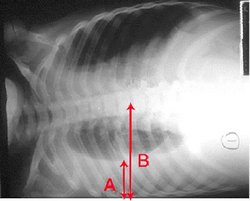PURPOSE: Tube thoracostomy is commonly used for the treatment of complicated pleural effusions. A fibrinolytic agent is often administered through the tube as an adjunctive treatment when drainage is deemed "inadequate", but this decision is neither standardized nor consistent. We examined the variations in the definition of inadequate drainage and the potential failure modalities associated with the procedure.
METHODS: This study applied probabilistic risk assessment (PRA) to perform a quantitative evaluation of different failure modalities. An event tree analysis was performed to model the temporal event sequence of identification of effusion location, assessment of loculation, and thoracostomy tube insertion and maintenance. Fault tree analysis was performed for each of these events taking into account multiple tube insertions, tube clogging and dislocations. Numerical values used for the quantification of tube thoracostomy failure were obtained from reviews of recently published trials and studies. A sensitivity analysis was also performed to prioritize the different failure contributors.
RESULTS: The analyses showed that the presence of multiple loculations contributes significantly to the overall rate of tube thoracostomy failure in about 50% of cases. There are other failure modalities that lead to inadequate tube drainage, many of which are operator dependent and others procedural and protocol dependent. Sensitivity analysis reveals that improvements in tube placement and in tube maintenance procedures could result in up to fifty percent reduction in tube thoracostomy failure. They may include pleural ultrasonography, and operator training.
CONCLUSION: Many factors contribute to failure of adequate tube thoracostomy drainage, the most important being loculations of the effusion. Failure rates may be reduced with improvements in procedures and protocols related to tube placement and maintenance.
CLINICAL IMPLICATIONS: This study reveals the potential difficulties of comparing different tube thoracostomy studies when the study populations comprise different loculated effusion percentages. Differences in tube insertion protocols and tube maintenance could also significantly affect the success of tube drainage. Our study further suggests that improvement in operator training in tube insertion and placement may reduce tube thoracostomy failure.
DISCLOSURE: Kelvin Shiu, None.
Kelvin K. Shiu DO * Mark J. Rosen MD Paul Mayo MD Beth Israel Medical Center, New York, NY
COPYRIGHT 2005 American College of Chest Physicians
COPYRIGHT 2005 Gale Group



